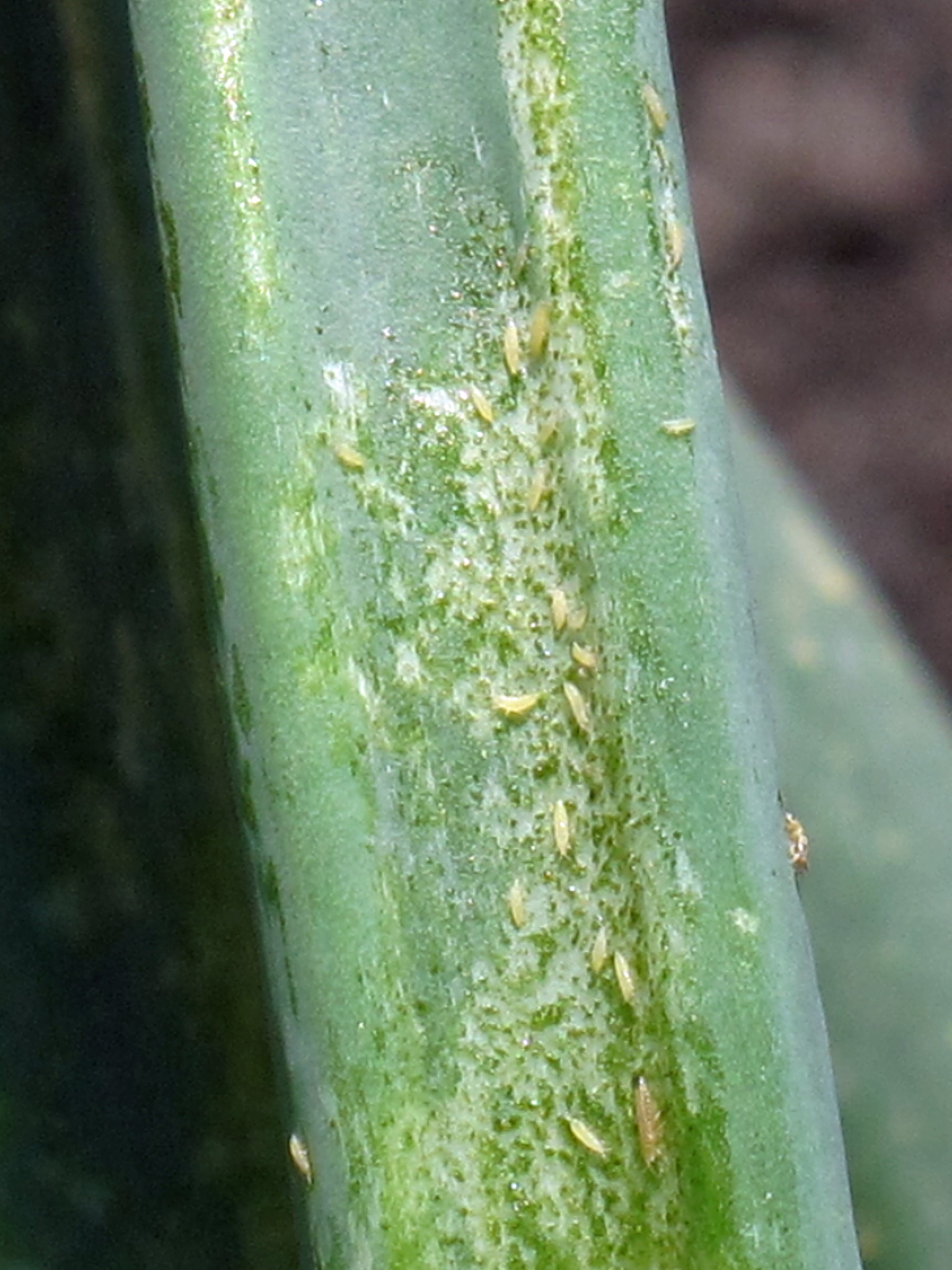
Thrips
Thrips Tabaci
Pathogen:
Insect
Type:
Risk:
INTERMEDIATE
Trips
Cebolla

WHO CAUSES IT?
Thrips, also known as Thysanoptera, are small, elongated insects that can cause significant damage to onion crops. Thrips feed on plant tissues, especially leaves and young shoots, using their scraping mouthparts to extract cellular juices. Females lay eggs in plant tissue, and larvae emerge to feed. Thrips can complete their life cycle quickly, especially in hot, dry conditions.
SYMPTOMS
Thrips cause a range of damage to onions, including discoloration and silvering of leaves due to their feeding. Additionally, they can act as vectors for viruses and other pathogens, increasing the risk of secondary diseases.
• Discoloration and silvering of the leaves.
• Damage to tender shoots, which can result in deformation.
• General weakening of the plant and reduction in the quality and quantity of the harvest.
• It can act as a vector for viruses, aggravating plant health problems.


TEMPERATURE AND HUMIDITY
20 ºC - 30ºC
40% - 60%
TRANSMISSION ROUTES
Flight of adults, contact with infected plants, eggs laid on leaves.
Do you want to remove this pest? Choose how you want to treat it.
TREATMENTS
Chemical treatments
• ORANGE OIL 60g/L [ME] P/S
• PARAFFIN OIL (CAS [64742-46-7]) 79% [EC] P/V
• PARAFFIN OIL (CAS [8042-47-5]) 54.6% [EW] P/V
• AZADIRACTIN 1% (AS AZADIRACTIN A) [EC] P/V
• Azadirachtin 2.6% (AS AZADIRACTIN A) [EC] P/V
• CYPERMETHRIN 5% [EC] P/V
• DELTAMETHRIN 1.5% [EW] P/V
• DELTAMETHRIN 1.57% [SC] P/V
• DELTAMETHRIN 10% [EC] P/V
• DELTAMETHRIN 2.5% [EC] P/V
• LAMBDA CYHALOTHRIN 1.5% [CS] P/V
• LAMBDA CYHALOTHRIN 10% [CS] P/V
• POTASSIUM SALTS OF FATTY ACIDS C14-C20 48% [EW] P/V
• SPINOSAD 48% [SC] P/V
• CHROMATIC TRAP
• ADHESIVE TRAP
Authorized treatments in organic farming
• ORANGE OIL 60g/L [ME] P/S
• PARAFFIN OIL (CAS [64742-46-7]) 79% [EC] P/V
• PARAFFIN OIL (CAS [8042-47-5]) 54.6% [EW] P/V
• AZADIRACTIN 1% (AS AZADIRACTIN A) [EC] P/V
• Azadirachtin 2.6% (AS AZADIRACTIN A) [EC] P/V
• LAMBDA CYHALOTHRIN 1.5% [CS] P/V
• LAMBDA CYHALOTHRIN 10% [CS] P/V
• POTASSIUM SALTS OF FATTY ACIDS C14-C20 48% [EW] P/V
• SPINOSAD 48% [SC] P/V
• CHROMATIC TRAP
• ADHESIVE TRAP
Biological control
• BEAUVERIA BASSIANA (STRAIN ATCC 74040) 2.3% (2.3X10E7 VIABLE SPORES/ML) [OD] P/V
• BEAUVERIA BASSIANA (GHA STRAIN) 22% (4.4 x 10E10 CONIDIAS/G) [WP] P/P
• BEAUVERIA BASSIANA strain PPRI 5339 8% (8 X 10E12 CFU/L) [OD] P/P
• METARHIZIUM BRUNNEUM strain Ma 43 10.5% [OD] P/V
• PAECILOMYCES FUMOSOROSEUS (STRAIN FE 9901) 18% (2 X 10 E9 CFU/G) [WP] P/P
• STEINERNEMA FELTIAE (Parasitoid and predatory nematodes)
• CHRYSOPERLA CARNEA (Parasitoid and predatory insects)
• HETERORHABDITIS BACTERIOPHORA (Parasitoid and predatory nematodes)
• AMBLYDROMALUS LIMONICUS (Parasitoid and predatory mites)
• MACROCHELES ROBUSTULUS (Parasitoid and predatory mites)
• MACROLOPHUS PYGMAEUS (Parasitoid and predatory insects)
• TRANSEIUS MONTDORIENSIS (Parasitoid and predatory mites)
• AMBLYSEIUS SWIRSKII (Parasitoid and predatory mites)
• NEOSEIULUS CUCUMERIS (Parasitoid and predatory mites)
• ORIUS LAEVIGATUS (Parasitoid and predatory insects)
Recommendations
• Maintain a regular monitoring program to detect and treat the infestation early.
• Use colored sticky traps to capture adults and monitor their presence.
• Practice crop rotation to reduce pest pressure on the soil.
• Use thrips-resistant onion varieties when available.
• Promote natural enemies, such as predatory mites and parasitic wasps, to control the thrips population.
• Apply specific insecticides according to local recommendations when necessary.
Sponsored link
Sponsored link
Sponsored link
Sponsored link
Sponsored link
Sponsored link
Effective against all types of fungi
TREATMENTS
Homemade remedies
There are no home treatments
Natural allies
Chemical treatments
There are no treatments for this disease. Treatments are directed at the insect vectors that transmit it. See insect treatments.
RECOMMENDATIONS
- Check the back of the leaves frequently, especially in dry weather.
- Spray water on the leaves to increase humidity and prevent them from settling.
- Keep plants healthy with good watering and adequate light.
- If you see cobwebs or damage, clean the leaves with a damp cloth or pressurized water.
- Use potassium soap or neem oil every few days until they disappear.
REPELLENT PLANTS
Rosemary, Dill, Coriander
EFFECTIVE PRODUCTS TO ELIMINATE THIS PEST
Sponsored link
Sponsored link
Sponsored link
Sponsored link
Sponsored link
Sponsored link
Effective against all types of fungi
*The recommended treatments are recommendations based on the authorities' databases and do not replace in any way the guidelines established by the legislation of each country.
*Products shown are recommendations and not our own products. As Amazon Associates, we earn revenue from purchases of recommended products.






















